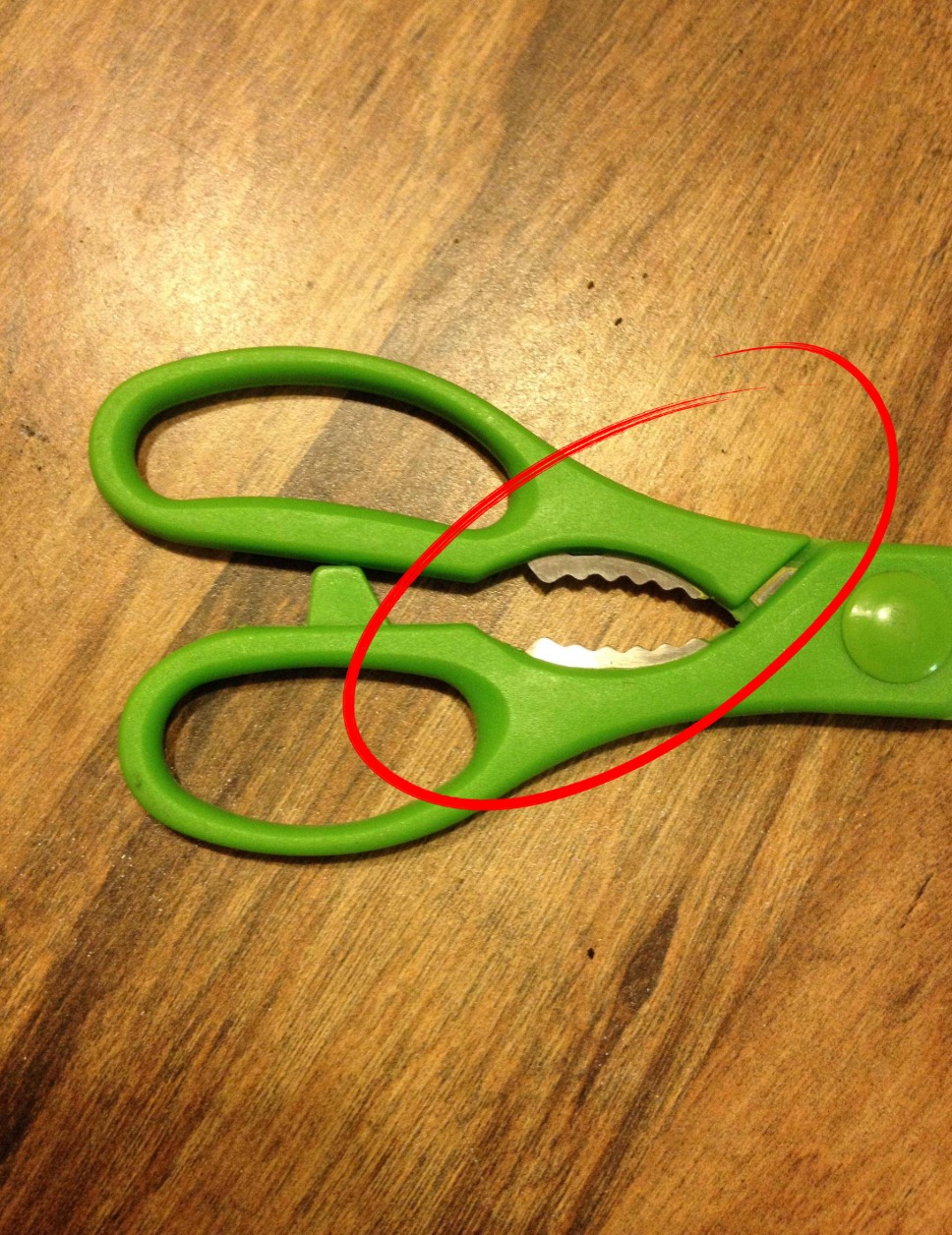If you’ve ever taken a closer look at your kitchen scissors, you might have noticed a small, jagged section between the handles—those little ridged teeth tucked just behind where your fingers grip. At first glance, it might seem like a random design detail, maybe even an unnecessary quirk from the manufacturer, and if you’ve never used it, you’re not alone.

Many people don’t realize that this part actually has a purpose, and it’s far more useful than it appears. That toothed area is an integrated feature that’s been quietly waiting to make your kitchen life easier, serving as a built-in gripping tool often referred to as a jar opener, nutcracker, or even a bone cracker depending on the brand. You’ll find it right where the handles begin to curve inward—sometimes it’s made of sturdy metal, other times reinforced plastic—but always rugged enough to handle a bit of pressure. Close the scissors slowly, and you’ll see how the ridges align, forming a firm gripping surface that’s perfect for holding onto something stubborn. One of its most common uses is opening tightly sealed jars and bottles without straining your wrists or resorting to awkward tricks.
If you’ve ever wrestled with a jam lid that refuses to budge, this is your solution. Simply close the scissors until the teeth just meet, slide the lid into the notched area so it fits snugly, hold the scissors steady with one hand, and twist the jar with the other. The grooves increase traction while applying even pressure, making it much easier to break the seal. This works just as well on smaller caps like soda or sauce bottles, and it’s a lifesaver for anyone with reduced grip strength or arthritis.
But jars aren’t the only thing this hidden tool can tackle. If you don’t own a nutcracker, your kitchen scissors can stand in for cracking shells on walnuts, pecans, or hazelnuts. Place the nut gently between the teeth, squeeze the handles slowly until you hear the shell crack, then rotate and repeat until you can peel the shell away. The key is to go slow so you don’t crush the nut inside. For those with heavy-duty kitchen shears, the ridged section can also help with breaking down poultry by gripping and snapping through small bones, such as those in chicken wings or thighs.
By holding the bone in the toothed section and applying steady, controlled pressure, you can prevent the scissors from slipping while giving yourself the leverage to cut cleanly. That said, you’ll want to avoid trying this with flimsy or inexpensive scissors, as you could damage them or risk injury. Beyond jars, nuts, and poultry, the toothed area has plenty of other potential uses. It can grip slippery plastic caps like those on vacuum-sealed juice jugs, crack crab legs or lobster shells, twist out soft synthetic corks, or hold onto a stubborn twist-tie or plastic seal so you can cut it cleanly. Essentially, whenever your hands are slipping and you’re on the verge of frustration, this small but mighty feature might be the answer.
Manufacturers include it because multi-function tools are increasingly popular, especially for people with small kitchens who value space-saving designs. Instead of buying a separate jar opener, nutcracker, and poultry shears, one good pair of multi-purpose kitchen scissors with a built-in gripper can do the job of all three. Not all scissors have this feature—it’s most commonly found on heavy-duty kitchen scissors, poultry or bone shears, and utility scissors marketed as multi-purpose. To check, look between the handles for a notched or ridged section that lines up when the scissors are closed. If it’s there, you’ve got a built-in helper ready to go. Of course, there are a few safety tips to keep in mind. Don’t force it on anything too hard, like extremely tough nuts or thick bones your scissors aren’t designed for.
Keep your fingers clear of the teeth when applying pressure, and always clean the area thoroughly after use, especially if it’s come into contact with raw meat or sticky residue, since the grooves can trap debris. And as tempting as it may be, don’t use it for non-food tasks like opening paint cans or twisting wires—that’s a quick way to ruin your scissors. While it might look like an insignificant notch, that toothed part of your kitchen scissors is a small powerhouse. It transforms an ordinary cutting tool into a mini multi-tool that can twist, crack, grip, and open with minimal effort. The next time you grab your kitchen shears, remember you’re holding more than just scissors—you’ve got a built-in problem-solver sitting right in your hand, ready to tackle everyday kitchen challenges with ease.





